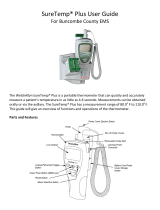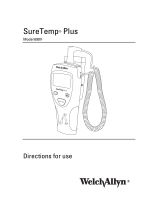Page is loading ...

Accuracy Study for the Welch Allyn
®
Model 692/690 SureTemp
®
Plus
Oral, Adult Axillary, and Rectal Thermometer

Accuracy Study for the Welch Allyn
®
Model 692/690 SureTemp
®
Plus
Oral, Adult Axillary, and Rectal Thermometer
Clinical accuracy studies were performed using the
SureTemp
®
Plus in the oral, adult axillary (18 years and
older), and rectal modes. Over 220 temperature
measurements were obtained from over 8 clinical sites. Thirty
percent of all data represent fevers. Temperatures ranged
from 93.7° F (34.27° C) to 105.0° F (40.55° C). Subjects
ranged in age from 7 months to 87 years. Accuracy results
for each site (oral, adult axillary, and rectal) are listed below.
For the combined data, the average error is -0.05° F (-0.027°
C) with a Standard Deviation of 0.355° F (0.197° C) (
Table 1).
Monitor Mode Temperature: Monitor mode is a
function of an electronic thermometer used to monitor a
temperature reading until it reaches the thermal steady
state. The thermal steady state for oral and rectal
temperatures is reached in approximately three minutes.
The thermal steady state for axillary temperatures is
reached in approximately five minutes.
Predicted Temperatures: Predicted temperatures are
from any thermometer that renders a temperature reading
before the steady state is achieved. Predictive
thermometers reduce the time required for measurement
by predicting what the temperature would be if the probe
were left in the site until steady state is reached.
Fever: For the purposes of this study, fever is defined as
any temperature equal to or greater than 100.0° F (37.77° C).
Data set: A data set is defined as a predicted
temperature followed by a three-minute (oral and rectal) or
a five-minute (axillary) monitor mode reference
temperature.
Normal body temperature in a healthy person is a
range that fluctuates throughout the day. Body
temperature can vary as much as 1° F to 2° F (0.5° C to 1.0°
C) over a twenty-four hour period. Body temperature is
lowest in the morning
(2-4 am) while resting and warmest in the afternoon
(4-6 pm) while active. Body temperature is regulated by
the hypothalamus, which continually adjusts
temperature to stay within a set range of normal in the
absence of illness (
Table 2). Fever is defined as a
temperature above an individual's range of normal.
Fever has always been recognized as an indication
of illness. Today, in every clinical setting, the primary
purpose for taking a patient's temperature is to screen
for fever and to follow its course. Timely, accurate
temperature measurement has always been an
essential part of patient assessment.
Thermometer technology has changed over recent
years. Temperature taking is FAST and clinicians must
rely on a thermometer’s accuracy to make important
and informed decisions for patient care.
The purpose of this clinical paper is to summarize
the studies performed to demonstrate the accuracy of
the Welch Allyn
®
SureTemp Plus thermometer in the
oral, adult axillary, and rectal predictive modes.
Six critical care nurses, trained on the use of the
SureTemp Plus, collected the data. All thermometers
and probes were tested for accuracy before and after
the study in a stirred water bath at three different
temperatures as per ASTM testing standards.
Over 220 data sets were collected, with 30% of all
data defined as febrile. For each subject, an initial oral,
adult axillary, or rectal temperature was taken in the
predict mode. Once the temperature was recorded, the
probe was left in place and the thermometer was
switched to the monitor mode for three minutes (oral
and rectal) or five minutes (adult axillary) to establish a
reference temperature. A direct comparison was then
made between each predicted temperature and the
corresponding reference temperature for each data set.
Data were analyzed by comparing each subject's
predicted temperature to the corresponding three or
five-minute monitor mode reference temperature.
Data Analysis:
Materials and Methods:
Overview:
Definitions:
Summary:

Oral Data
Oral temperatures ranged from 97.1° F (36.16° C) to
102.6° F (39.22° C). The total number of data sets were
91, with 27 of those being febrile. Subjects ranged in
age from 11 years to 87 years. The average error was
-0.03° F (-0.016° C) with a Standard Deviation of 0.358° F
(0.198° C).
Adult Axillary Data (18 years and older)
Adult Axillary temperatures ranged from 93.7° F (34.27°
C) to 105.0° F (40.55° C). The total number of data sets
were 92, with 29 of those being febrile. Subjects ranged
in age from 18 years to 85 years. An equal number of
adult axillary data sets were collected from three age
groups: 18 years to 30 years, 31 years to 60 years, and
65+ years. The average error was -0.10° F (-0.055° C)
with a Standard Deviation of 0.373° F (0.207° C).
Rectal Data
Rectal temperatures ranged from 97.1° F (36.16° C) to
102.9° F (39.38° C). The total number of data sets were 40,
with 12 of those being febrile. Subjects ranged in age from
7 months to 79 years. The average error was 0.01° F
(0.005° C) with a Standard Deviation of 0.290° F (0.160° C).
Statistically, analyses show no clinically significant
differences between the predicted temperatures and the
monitor mode reference temperatures from the SureTemp
Plus in the oral, adult axillary, and rectal modes. The
researchers of this study support the use of this
thermometer in today's fast-paced clinical setting. The
accuracy and speed of the device provides clinicians with
an added level of confidence when assessing and caring
for their patients.
Conclusion:
Results:
SureTemp
®
Plus Monitor Mode
Temperature vs. Predicted Temperature
Oral, Adult Axillary, and Rectal Modes
92
94
96
98
100
102
104
106
92 94 96 98 100 102 104 106
Predicted Temperature
Monitor Mode Temperature
Average Error -0.05°F
Standard Deviation 0.355°F
Table 1

0 - 2 years 3 - 10 years 11- 65 years > 65 years
99.5
95.9
99.6
97.6
98.5
96.4
—
100.4
97.9
100.6
98.6
97.1
98.096.6 98.495.3 97.496.0
100.0
97.0
99.7
96.6
99.5
96.4
OOrraall
RReeccttaall
AAxxiillllaarryy
EEaarr
100.4
97.9
99.194.5
100.4
97.5
°F
100.0
97.5
100.2
98.2
98.8
96.6
CCoorree
100.0
97.5
99.2
Normal Body Temperature Ranges
Normal body temperature is a range. This table shows that normal
temperatures vary by site. Therefore, readings from different sites,
even if taken at the same time, should not be directly compared.
RReeffeerreenncceess
Chamberlain, J. & Terndrup, T., et. al.; “Determination of Normal Ear Temperature Using an Infrared
Emission Detection Thermometer”; Annals of Emergency Medicine; January, 1995.
Braun, S., Preston, P., and Smith, R.; “Getting a Better Read on Thermometry”; RN Magazine; March,
1998.
“Temperature Measurement in Paediatrics”; Paediatric Child Health Vol 5 No 5; July / August, 2000.
Brunner, L. and Suddarth, D., et. al.; The Lippincott Manual of Nursing Practice; 1982; p.1145.
Erickson, R., Temperature Taking Sourcebook; IVAC Corporation, San Diego, CA, 1993.
Houdas, Y., et. al.; Human Body Temperature, Its Measurement and Regulation; 1982; p.81-87.
American Medical Association's International Classification of Diseases 9th Revision Clinical
Modificiation; Physician ICD-9-CM, 2003 Volumes 1 and 2; Ingenix, Inc., July, 2002; p.6.
Copyright © 2003 Welch Allyn, Inc.
All rights reserved
Reorder # SM2557 Rev. A
CUSTOMER SERVICE
For customer service, technical or
clinical support, please contact
Welch Allyn at (800) 535-6663.
www.welchallyn.com
Eleanor Fitzgerald, RN, BSN
Clinical Marketing Manager
Table 2
/








